User Experience (UX) will never be the same again! The term “User Experience Design” was coined by Don Norman in the 90’s, when he joined Apple as the Vice president of research.
Myth #31: UX design is a step in a project
Many think that user experience design is confined to sketching the interfaces. However, UX design is a much broader process that – ideally – starts at the strategy level and affects the whole lifecycle of a project or a business.
Esta sección está basada en el trabajo: Masip, L.; Oliva, M.; Granollers, T. User Esperience Specification User experience specification through quality attributes. Proceedings of the 13th IFIP TC 13 International Conference on Human-Computer Interaction, INTERACT’11, P. Campos, N. Nunes, N. Graham, J. Jorge, P. Palanque and M. Winckler (Eds.), Part IV. Springer-Verlag, Berrlin, Heidelberg, V. 6949, pp. 656-660. Disponible en Internet en: http://link.springer.com/chapter/10.1007%2F978-3-642-23768-3_106. Here you also can find the POSTER version of this work.
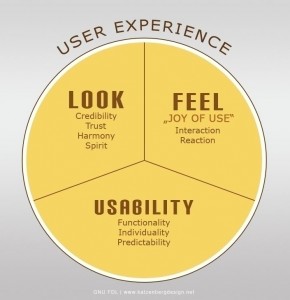
El término Experiencia de Usuario, User eXperience en inglés (UX), resulta ampliamente utilizado dentro del ámbito de la Interacción Persona-Ordenador (IPO), desplazando incluso en muchos casos el término mayormente utilizado: Usabilidad.
Actualmente, el estándar que define la calidad de un sistema o producto software es la norma SQuaRE (Systems and Software Quality Requirements and Evaluation) [1], que constituye la segunda generación de normas de calidad, en sustitución de la norma ISO 9126 [2], siendo la norma ISO/IEC 25010:2011 la que presenta el modelo de calidad. En dicha norma, el concepto habitualmente conocido mediante el término Usabilidad constituye una de las categorías del estándar e incluye atributos más específicos. Aun así, esta nueva versión del estándar todavía no considera explícitamente otras características o facetas ampliamente utilizadas en la actualidad por la comunidad científica para evaluar la UX de un sistema interactivo. A la vez, en el ámbito profesional de la IPO no se dispone de un consenso claro en cuanto a una definición estándar para la UX, ni existe consenso a la hora de qué atributos considerar para analizar la UX que los usuarios perciben en el uso de un sistema interactivo concreto.
La Experiencia de Usuario
Como ya se ha indicado anteriormente, no existe un consenso en cuanto a la definición de la UX ni del uso de los distintos términos relacionados con ella. Los apartados que siguen contienen los términos elegidos, de entre los más comúnmente utilizados, como más apropiados y las facetas; así como una definición de UX general, que permiten sentar las bases del trabajo a realizar.
Los elementos de la UX
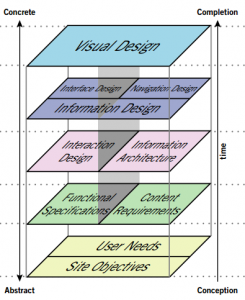 J.J. Garret, en el año 2000, crea el diagrama Los Elementos de la Experiencia de Usuario, esquema que determina de forma muy clara todos los elemntos que deben estar presentes cuando se habla de eXperiencia de Usuario, y que claramente puede observarse que la usabilidad es solo uno de dichos elementos.
J.J. Garret, en el año 2000, crea el diagrama Los Elementos de la Experiencia de Usuario, esquema que determina de forma muy clara todos los elemntos que deben estar presentes cuando se habla de eXperiencia de Usuario, y que claramente puede observarse que la usabilidad es solo uno de dichos elementos.
Del mismo autor es uno de los libros fundamentales acerca de la UX: The Elements of User Experience User-Centered Design for the Web
Términos implicados en la definición de experiencia de usuario
Propiedades, facetas, dimensiones, características, subcaracterísticas, categorías, atributos, son términos frecuentemente utilizados dentro del ámbito de la UX y de la disciplina de la IPO.
A saber:
- Faceta: determina todos los componentes de la UX.
- Atributo : todas las características, subcaracterísticas y atributos contemplados en el estándar ISO, teniendo en cuenta que en cualquier caso los tres conceptos pueden considerarse como sinónimos.
- Dimensión: todos los atributos de calidad medibles presentados en el estándar ISO 2502n referentes a la medida de la calidad de un producto.
Facetas de la UX
Las facetas que se consideran en la UX, y que se utilizan para el diseño o evaluación de un sistema interactivo, todavía no están consensuadas ni por la comunidad científica ni por ningún organismo de estandarización.
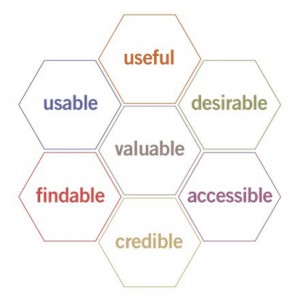 Uno de los autores referentes en este ámbito es Peter Morville [5], quien definió la colmena de la UX en la que se incluyen: usable, útil, deseable, valioso, creíble, encontrable y accesible como atributos a considerar para obtener una UX positiva.
Uno de los autores referentes en este ámbito es Peter Morville [5], quien definió la colmena de la UX en la que se incluyen: usable, útil, deseable, valioso, creíble, encontrable y accesible como atributos a considerar para obtener una UX positiva.
Otros autores destacados como Hassenzahl y Tractinsky [6] proponen, de acuerdo a una revisión de la literatura, tres facetas para la UX: más allá de lo instrumental, experimental y emociones y afectos. Entre los referentes nacionales destacan Hassan Montero y Ortega Santamaría, quienes señalan que los componentes más importantes de la UX son usuario, contexto y contenido [7].
Adicionalmente, otros autores han ido definiendo otros conceptos que pueden conformar la UX: accesibilidad [8], emotividad [9], comunicabilidad [10], multiculturalidad [11], plasticidad [12], jugabilidad [13] y dependabilidad [14], entre otros.
Así pues, dependiendo del autor y de las necesidades específicas para cada diseño o evaluación, se utilizan unas u otras facetas que se adecuan mejor a cada sistema interactivo concreto. En ocasiones, estas facetas son utilizadas sin considerar qué atributos, de los presentados en el estándar ISO, se refieren a cada una de ellas.
El objetivo de esta sección no es escoger un conjunto de facetas concreto, sino disponer del conjunto de facetas más amplio posible que permita realizar el análisis objeto de este trabajo.
Definición de la UX
Existen distintas definiciones de la UX utilizadas por los profesionales en el área, siendo una de las más destacadas la definición de UX presentada en el estándar ISO DIS 9241-210:2008 [15]:
“A person’s perceptions and responses that result from the use and/or anticipated use of a product, system or service.”
Otras definiciones destacables (recopiladas a su vez por E. L Law et al. en [16]):
- “Encompasses all aspects of the end-user’s interaction with the company, its services, and its products. The first requirement for an exemplary user experience is to meet the exact needs of the customer, without fuss or bother. Next comes simplicity and elegance that produce products that are a joy to own, a joy to use. True user experience goes far beyond giving customers what they say they want, or providing checklist features. In order to achieve high-quality user experience in a company’s offerings there must be a seamless merging of the services of multiple disciplines, including engineering, marketing, graphical and industrial design, and interface design.” [17]
- “A consequence of a user’s internal state (predispositions, expectations, needs, motivation, mood, etc.), the characteristics of the designed system (e.g. complexity, purpose, usability, functionality, etc.) and the context (or the environment) within which the interaction occurs (e.g. organisational/social setting, meaningfulness of the activity, voluntariness of use, etc.)” [6]
- “The entire set of affects that is elicited by the interaction between a user and a product including the degree to which all our senses are gratified (aesthetic experience) the meanings we attach to the product (experience of meaning) and the feelings and emotions that are elicited (emotional experience).” [18]
- “The value derived from interaction(s) [or anticipated interaction(s)] with a product or service and the supporting cast in the context of use (e.g. time, location, and user disposition).” [19]
- “The quality of experience a person has when interacting with a specific design. This can range from a specific artefact such as a cup toy or website up to larger integrated experiences such as a museum or an airport.” [20]
A pesar de que las definiciones presentadas son absolutamente válidas en contextos de uso específicos, en general no abarcan todos los aspectos que se deberían considerar para evaluar la UX que se obtiene al interactuar con un sistema interactivo.
En algunas de las definiciones, como en [15] y [20], la parte del contexto de la interacción no se explicita suficientemente. En [17] se centran en cuestiones de interacción con una empresa. En otras definiciones no se ven consideradas claramente algunas de las facetas, como la accesibilidad en [6], ya que solo detalla el estado interno del usuario y no el externo o físico, u otras facetas como multiculturalidad o adaptabilidad en [18] y [19].
De acuerdo con todas las consideraciones realizadas en las definiciones de la UX, se propone la siguiente definición más general de forma que cubra todos los aspectos requeridos:
La experiencia de usuario atiende a todos los factores, tanto internos como externos del usuario y del sistema interactivo, que causen alguna sensación a quien esté utilizando un sistema interactivo concreto en un determinado contexto de uso.
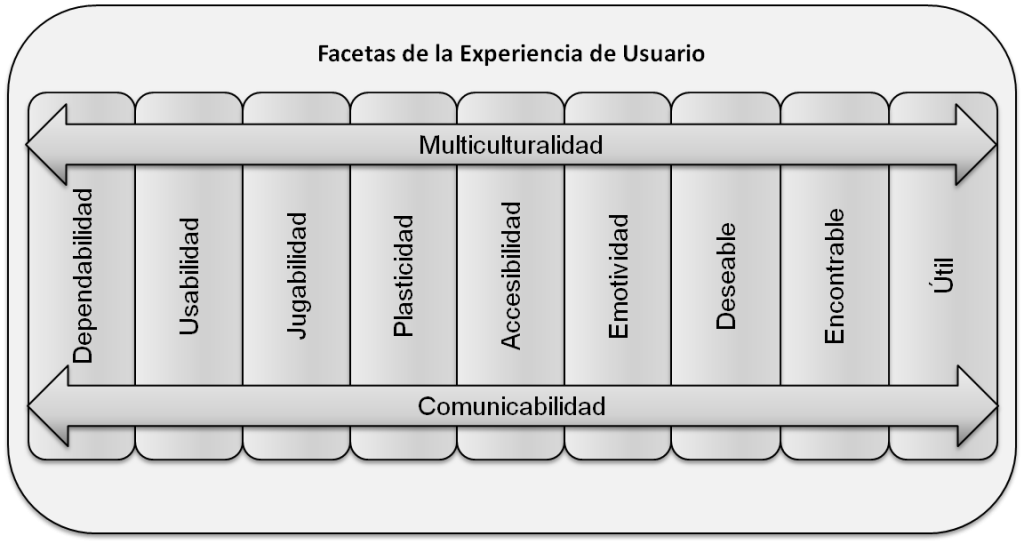
Un buen ejemplo de lo que es UX
Para finalizar …
Lecturas recomendadas
- The ultimate guide to user experience, by Tom May, July 24, 2014.
- 8 Must-see UX Diagrams, by Andrew Maier on September 9, 2010.
- Hassenzahl, Marc (2013): User Experience and Experience Design. In: Soegaard, Mads and Dam, Rikke Friis (eds.). «The Encyclopedia of Human-Computer Interaction, 2nd Ed.». Aarhus, Denmark: The Interaction Design Foundation.
- 10 Things To Know About Variability In The User Experience, by Jeff Sauro, March 18, 2014
- UX is not UI, by Erik Flowers, December 15, 2012.
- Where UX Comes From, by UX BOOTH on August 8, 2013
- The Gap between UI and UX Design – Know the Difference, by Helga Moreno on 24th Apr 2014
- Future Proofing Tomorrow’s Technology: UX for an Aging Population, by C. Wilkinson & D. Gandhi on February, 2015
- Top UX myths; because sometimes it’s easier to explain what it’s not! by Rob Deeganon April, 2015
Referencias
- 1. ISO, International Software Quality Standard, ISO/IEC 25010. Systems and software engineering-Systems and software Quality Requirements and Evaluation (SQuaRE) System and software quality models (2011)
- 2. ISO, International Standard ISO/IEC 9126: Software Engineering – Product Quality.
- 3. Masip, L.; OPEN-HEREDEUX: OPEN HEuristic REsource for Designing and Evaluating User eXperience. Doctoral Consortium communication accepted at Interact 2011.
- 4. Masip, L., Oliva, M., Granollers, T. Classification of interactive systems components enables planning heuristic evaluation easier. HCI International 2011. Accepted paper.
- 5. Morville, P. Experience design unplugged. In ACM SIGGRAPH 2005 Web program (SIGGRAPH ’05), Nishant Kothary (Ed.). ACM, New York, USA, Article 10. (2005)
- 6. Hassenzahl, M., Tractinsky, N. User Experience – a research agenda [Editorial]. Behavior & Information Technology, 25(2), pp 91-97. (2006)
- 7. Hassan-Montero, Y., Ortega-Santamaría, S. Informe APEI sobre usabilidad. APEI, Asociación Profesional de Especialistas en Información. (2009)
- 8. W3C (2008). Web Content Accessibility Guidelines 2.0. W3C Candidate Recommendation April 2008.[http://www.w3.org/TR/WCAG20/]
- 9. Leitner, G., Hitz, M., Melcher, R. The Role of Usability in the Design and Evaluation of Dynamic Traffic Displays. In Proceedings of the 4th Symposium of the Workgroup Human-Computer Interaction and Usability Engineering of the Austrian Computer Society on HCI and Usability for Education and Work (USAB ’08), Andreas Holzinger (Ed.). Springer-Verlag, Berlin, Heidelberg, pp 205-220 (2008).
- 10. Prates, R., de Souza, C., Simone D. J. Methods and tools: a method for evaluating the communicability of user interfaces. interactions 7, 1 (January 2000), 31-38. (2000)
- 11. Jiang, O. De Bruijn, O.; A. De Angeli. “The Perception of Cultural Differences” in Online Selfpresentation. T. Gross et al. (Eds.): INTERACT 2009, Part I, LNCS 5726, pp. 672–685, (2009).
- 12. Thevenin, D., Coutaz, J., Plasticity of User Interfaces: Framework and Research Agenda. Proceed. of INTERACT’99. Conference on Human-Computer Interaction, Vol. 1, pp. 110-117. (1999)
- 13. González, J.L.; Padilla, N. and Gutiérrez F. From Usability to Playability: Introduction to Player-Centred Video Game Development Process. In Proceedings of the 1st International Conference on Human Centered Design: Held as Part of HCI International 2009 (HCD 09), Masaaki Kurosu (Ed.). Springer-Verlag, Berlin, Heidelberg, pp 65-74. (2009)
- 14. Avizienis, A., Laprie, J.C., Randell, B., Landwehr, C. Basic Concepts and Taxonomy of Dependable and Secure Computing. IEEE Trans. Dependable Secur. Comput. 1, 1 (January 2004), pp 11-33. (2004)
- 15. ISO DIS 9241-210:2008. Ergonomics of human system interaction – Part 210: Human-centred design for interactive systems (formerly known as 13407). International Standardization Organization (ISO). Switzerland.
- 16. Lai-Chong, E., Roto, V., Hassenzahl, M., Vermeeren, A., Kort. J. Understanding, scoping and defining user experience: a survey approach. In Proceedings of the 27th international conference on Human factors in computing systems (CHI ’09). ACM, New York, NY, USA, pp 719-728. (2009)
- 17. http://www.nngroup.com/about/userexperience.html (última visita 4 marzo 2011)
- 18. Desmet. P. M. A.. & Hekkert. P.. Framework of product experience. International Journal of Design. 1(1), pp 57-66. (2007)
- 19. Sward D., & MacArthur, G.. Making user experience a business strategy. In E. Law et al. (eds.), Proceedings of the Workshop on Towards a UX Manifesto, 3 Sept. 2007, Lancaster, UK (pp 35-40). (2007)
- 20. http://www.uxnet.org/ (última visita 4 marzo 2011)
- 21. ISO. International Standard. ISO 13407. Human-centered design, processes for interactive systems (1991).
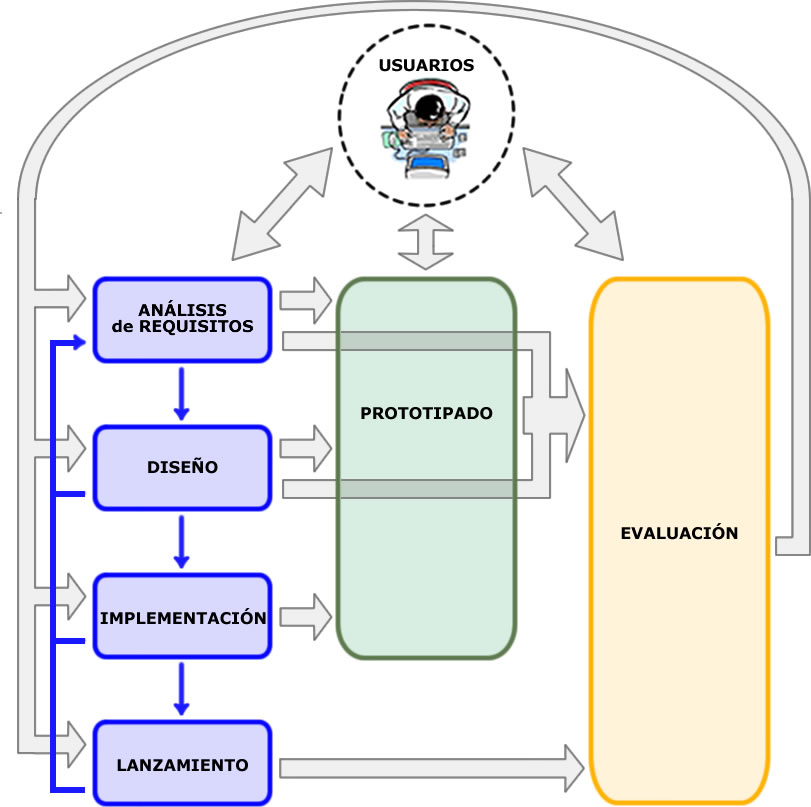
Un pensamiento en “User eXperience (UX)”
Los comentarios están cerrados.